Visible Triple-Wavelength Switchable Emission Generated in Passively Q-Switched Nd:YVO4 Self-Raman Laser
Abstract
1. Introduction
2. Crystal Analysis
3. Experimental Setup
4. Experimental Results and Discussion
5. Conclusions
Author Contributions
Funding
Institutional Review Board Statement
Informed Consent Statement
Data Availability Statement
Conflicts of Interest
References
- Gu, Y.G.; Niu, J.; Yang, J.; Xu, H.X. Application of laser in the medical field. Chin. Opt. 2023, 16, 283–295. [Google Scholar]
- Kachynski, A.V.; Pliss, A.; Kuzmin, A.N.; Ohulchanskyy, T.Y.; Baev, A.; Qu, J.; Prasad, P.N. Photodynamic therapy by in situ nonlinear photon conversion. Nat. Photonics 2014, 8, 455–461. [Google Scholar] [CrossRef]
- Pask, H.M.; Dekker, P.; Mildren, R.P.; Spence, D.J.; Piper, J.A. Wavelength-versatile visible and UV sources based on crystalline Raman lasers. Prog. Quantum Electron. 2008, 32, 121–158. [Google Scholar] [CrossRef]
- Kozak, I.; Luttrull, J.K. Modern retinal laser therapy. Saudi J. Ophthalmol. 2015, 29, 137–146. [Google Scholar] [CrossRef]
- Lock, J.H.J.; Fong, K.C.S. An update on retinal laser therapy. Clin. Exp. Optom. 2011, 94, 43–51. [Google Scholar] [CrossRef]
- Alexiades-Armenakas, M.R.; Dover, J.S.; Arndt, K.A. The spectrum of laser skin resurfacing: Nonablative, fractional, and ablative laser resurfacing. J. Am. Acad. Dermatol. 2008, 58, 719–737. [Google Scholar] [CrossRef]
- Hammann, E.; Behrendt, A.; Le Mounier, F.; Wulfmeyer, V. Temperature profiling of the atmospheric boundary layer with rotational Raman lidar during the HD(CP)2 Observational Prototype Experiment. Atmos. Chem. Phys. 2015, 15, 2867–2881. [Google Scholar] [CrossRef]
- Li, X.; Huang, S.H.; Sun, Z.H. Technology and equipment development in laser-induced fluorescence-based remote and field detection of biological aerosols. J. Biosaf. Biosecur. 2019, 1, 113–122. [Google Scholar] [CrossRef]
- Zeng, Z.Q.; Fu, S.; Zhang, H.H.; Dong, Y.H.; Cheng, J.L. A Survey of Underwater Optical Wireless Communications. IEEE Commun. Surv. Tutor. 2017, 19, 204–238. [Google Scholar] [CrossRef]
- Huo, X.W.; Qi, Y.Y.; Zhang, Y.; Chen, B.; Bai, Z.X.; Ding, J.; Wang, Y.L.; Lu, Z.W. Research development of 589 nm laser for sodium laser guide stars. Opt. Lasers Eng. 2020, 134, 106207. [Google Scholar] [CrossRef]
- Chen, H.; Cui, Y.F.; Li, X.W.; Zhang, B.Y.; Cai, Y.P.; Ding, J.; Qi, Y.Y.; Yan, B.Z.; Wang, Y.L.; Lu, Z.W.; et al. High-power dual-wavelength intracavity diamond Raman laser. Funct. Diam. 2023, 3, 2282527. [Google Scholar] [CrossRef]
- Chen, Y.F.; Pan, Y.Y.; Liu, Y.C.; Cheng, H.P.; Tsou, C.H.; Liang, H.C. Efficient high-power continuous-wave lasers at green-lime-yellow wavelengths by using a Nd:YVO4 self-Raman crystal. Opt. Express 2019, 27, 2029–2035. [Google Scholar] [CrossRef] [PubMed]
- Lee, A.J.; Spence, D.J.; Piper, J.A.; Pask, H.M. A wavelength-versatile, continuous-wave, self-Raman solid-state laser operating in the visible. Opt. Express 2010, 18, 20013–20018. [Google Scholar] [CrossRef]
- Ding, S.H.; Zhang, X.Y.; Wang, Q.P.; Su, F.F.; Jia, P.; Li, S.T.; Fan, S.Z.; Chang, J.; Zhang, S.S.; Liu, Z.J. Theoretical and experimental study on the self-Raman laser with Nd:YVO4 crystal. IEEE J. Quantum Electron. 2006, 42, 927–933. [Google Scholar] [CrossRef]
- Fan, L.; Zhao, W.Q.; Qiao, X.; Xia, C.Q.; Wang, L.C.; Fan, H.B.; Shen, M.Y. An efficient continuous-wave YVO4/Nd: YVO4/YVO4 self-Raman laser pumped by a wavelength-locked 878.9 nm laser diode. Chin. Phys. B 2016, 25, 114207. [Google Scholar] [CrossRef]
- She, K.; Zhou, P.F.; Wei, Y.; Xu, S.; Li, B.X.; Liao, W.B.; Lin, Z.L.; Zhang, G. Manipulation of linearly polarized states in a c-cut Nd: YVO4 passively Q-switched self-Raman laser. Appl. Phys. B 2024, 130, 51. [Google Scholar] [CrossRef]
- Wang, X.L.; Wang, X.J.; Dong, J. Multiwavelength, sub-nanosecond Yb: YAG/Cr4+: YAG/YVO4 passively Q-switched Raman microchip laser. IEEE J. Sel. Top. Quantum Electron. 2018, 24, 1–8. [Google Scholar]
- Ma, Y.; Lee, A.J.; Pask, H.M.; Miyamoto, K.; Omatsu, T. Direct generation of 1108 nm and 1173 nm Laguerre-Gaussian modes from a self-Raman Nd:GdVO4 laser. Opt. Express 2020, 28, 24095–24103. [Google Scholar] [CrossRef]
- Chen, Y.F.; Huang, H.Y.; Lee, C.C.; Hsiao, J.Q.; Tsou, C.H.; Liang, H.C. High-power diode-pumped Nd:GdVO4/KGW Raman laser at 578 nm. Opt. Lett. 2020, 45, 5562–5565. [Google Scholar] [CrossRef]
- Zou, Q.S.; Sun, Q.H.; Dai, Z.H.; Ding, S.H. Efficient passively Q-switched Nd: KGW/Cr4+:YAG self-Raman laser. Appl. Phys. B 2024, 130, 150. [Google Scholar] [CrossRef]
- Tang, C.Y.; Zhuang, W.Z.; Su, K.W.; Chen, Y.F. Efficient Continuous-Wave Self-Raman Nd:KGW Laser With Intracavity Cascade Emission Based on Shift of 89 cm−1. IEEE J. Sel. Top. Quantum Electron. 2015, 21, 142–147. [Google Scholar] [CrossRef]
- Koechner, W. Solid-State Laser Engineering, 6th ed.; Springer: New York, NY, USA, 2006. [Google Scholar]
- Hsieh, C.L.; Huang, H.J.; Chen, C.L.; Liang, H.V.; Chen, Y.F. Selectable two-wavelength Nd:YVO4 Raman laser at 671 and 714 nm. Opt. Lett. 2023, 48, 1510–1513. [Google Scholar] [CrossRef]
- Lee, C.Y.; Chang, C.C.; Sung, C.L.; Chen, Y.F. Intracavity continuous-wave multiple stimulated-Raman-scattering emissions in a KTP crystal pumped by a Nd:YVO4 laser. Opt. Express 2015, 23, 22765–22770. [Google Scholar] [CrossRef]
- Li, D.; Huang, C.Y.; Chang, X.W.; Liang, H.C.; Chen, Y.F. Continuous-Wave Self-Raman Vanadate Lasers Generating Versatile Visible Wavelengths. Photonics 2024, 11, 601. [Google Scholar] [CrossRef]
- Chen, Z.P.; Chen, Z.H.; Pan, H.G.; Zhang, A.L.; Zhang, B.; Li, R.P.; Chen, C.Q.; Peng, Y.M.; Liu, Z.Z. Tunable and switchable multi-wavelength actively Q-switched erbium-doped fiber laser based on cascaded fiber filters and EOM. J. Opt. India 2023, 52, 2333–2341. [Google Scholar] [CrossRef]
- Zhang, H.N.; Chen, X.H.; Wang, Q.P.; Li, P. Dual-wavelength actively Q-switched diode-end-pumped ceramic Nd:YAG/BaWO4 Raman laser operating at 1240 and 1376 nm. Laser Phys. Lett. 2014, 11, 105806. [Google Scholar] [CrossRef]
- Duan, Y.M.; Zhu, H.Y.; Zhang, G.; Tang, D.Y. Multiple visible wavelength switchable cascaded self-Raman laser based on selective wave-mixing mechanism. Appl. Phys. Lett. 2023, 123, 261102. [Google Scholar] [CrossRef]
- Ma, Y.F.; Li, X.D.; Yu, X.; Fan, R.W.; Yan, R.P.; Peng, J.B.; Xu, X.R.; Sun, R.; Chen, D.Y. A novel miniaturized passively Q-switched pulse-burst laser for engine ignition. Opt. Express 2014, 22, 24655–24665. [Google Scholar] [CrossRef] [PubMed]
- Mao, W.J.; Zhang, D.; Lu, H.Q.; Zhu, X.L.; Li, Z.H.; Wang, H.Y.; Duan, Y.M.; Zhu, H.Y. Compact passively Q-switched KTA self-frequency doubled Raman laser with 671 cm−1 shift. Opt. Laser Technol. 2022, 156, 108619. [Google Scholar] [CrossRef]
- Tang, J.L.; Bai, Z.X.; Zhang, D.; Qi, Y.Y.; Ding, J.; Wang, Y.L.; Lu, Z.W. Advances in All-Solid-State Passively Q-Switched Lasers Based on Cr4+:YAG Saturable Absorber. Photonics 2021, 8, 93. [Google Scholar] [CrossRef]
- Zhang, L.; Duan, Y.M.; Sun, Y.L.; Chen, Y.J.; Li, Z.H.; Zhu, H.Y.; Zhang, G.; Tang, D.Y. Passively Q-switched multiple visible wavelengths switchable YVO4 Raman laser. J. Lumin. 2020, 228, 117650. [Google Scholar] [CrossRef]
- Li, Y.H.; Huang, X.H.; Mao, W.J.; Xu, J.; Duan, Y.M.; Zhu, H.Y. Compact 589 nm yellow source generated by frequency-doubling of passively Q-switched Nd:YVO4 Raman laser. Microw. Opt. Technol. Lett. 2023, 65, 1122–1126. [Google Scholar] [CrossRef]
- Ding, S.L.; Yang, X.T.; Zhang, Q.L.; Liu, W.P.; Luo, J.Q.; Sun, G.H.; Ma, Y.F.; Sun, D.L. Diode-pumped passively Q-switched Nd : GdNbO4 laser with Cr4+ : YAG saturable absorber. Opt. Eng. 2017, 56, 086111. [Google Scholar] [CrossRef]
- Kaminskii, A.A.; Ueda, K.; Eichler, H.J.; Kuwano, Y.; Kouta, H.; Bagaev, S.N.; Chyba, T.H.; Barnes, J.C.; Gad, G.M.; Murai, T. Tetragonal vanadates YVO4 and GdVO4–new efficient χ(3)-materials for Raman lasers. Opt. Commun. 2001, 194, 201–206. [Google Scholar] [CrossRef]
- Sun, Y.L.; Duan, Y.M.; Cheng, M.Y.; Yuan, X.Z.; Zhang, L.; Zhang, D.; Zhu, H.Y. Triple wavelength-switchable lasing in yellow-green based on frequency mixing of self-Raman operation. Acta Phys. Sin. 2020, 69, 124201. [Google Scholar] [CrossRef]
- Chen, H.; Wu, E.; Zeng, H.P. Comparison between α-cut and off-axially cut Nd:YVO4 lasers passively Q-switched with a Cr4+:YAG crystal. Opt. Commun. 2004, 230, 175–180. [Google Scholar] [CrossRef]
- Duan, Y.M.; Xu, J.; Wei, Y.; Jin, X.X.; Li, Z.H.; Zhu, H.Y. Yellow-orange wavelength-switchable laser emission generated from c-cut Nd:YVO4 self-Raman with 890 and 259 cm−1 shifts. J. Lumin. 2024, 267, 120402. [Google Scholar] [CrossRef]
- Chen, Y.F. Efficient subnanosecond diode-pumped passively Q-switched Nd:YVO4 self-stimulated Raman laser. Opt. Lett. 2004, 29, 1251–1253. [Google Scholar] [CrossRef]
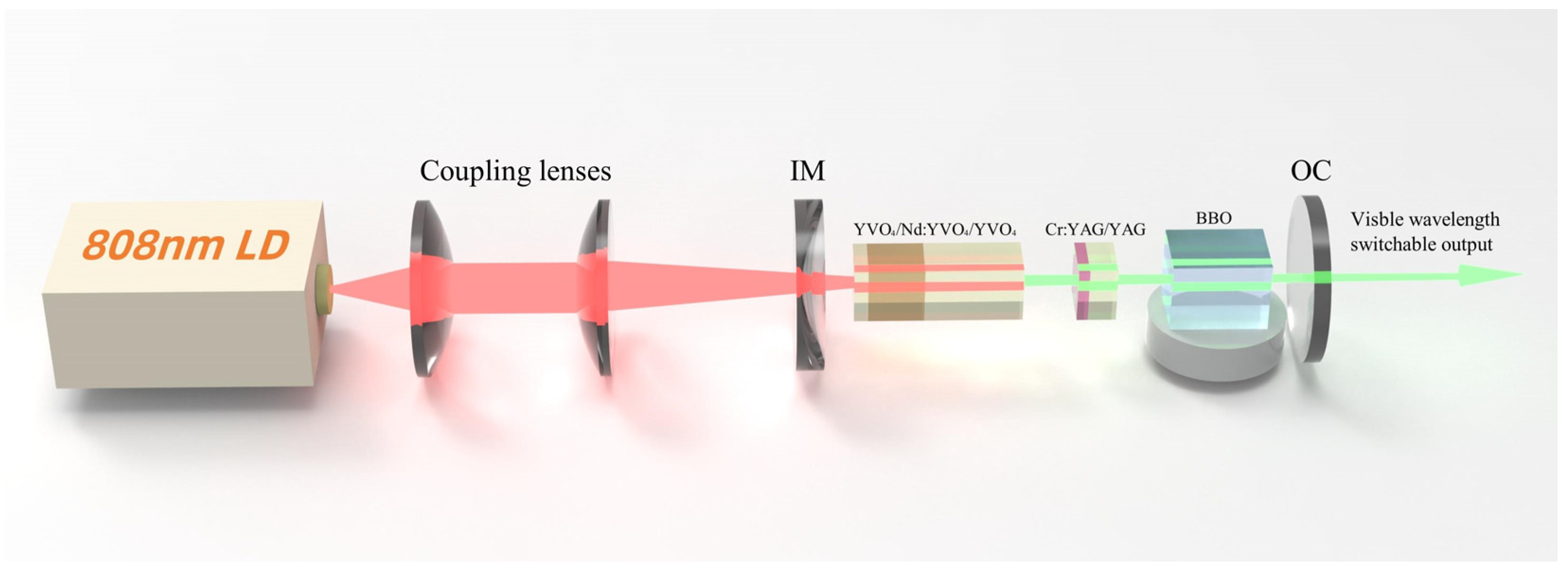
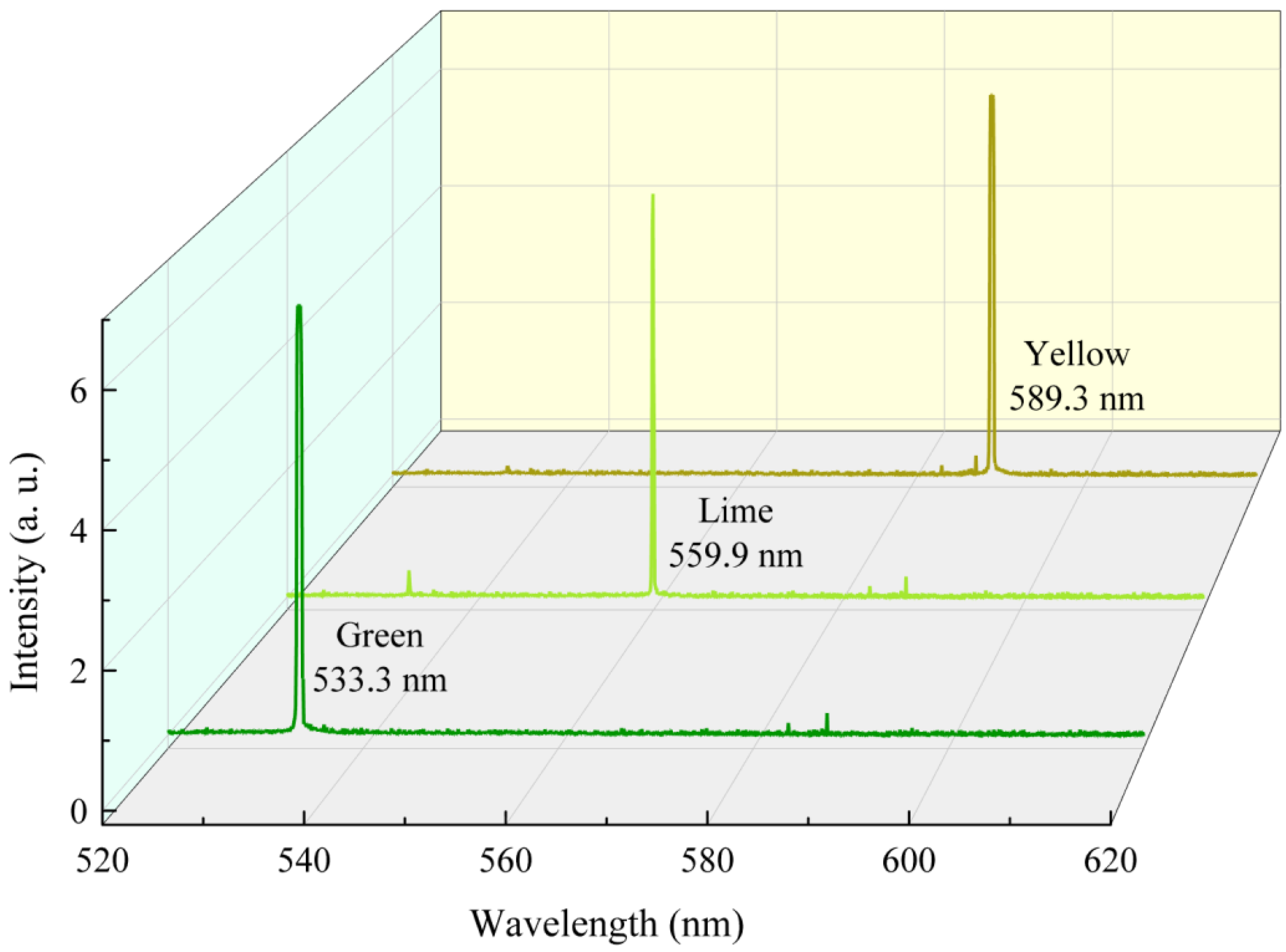
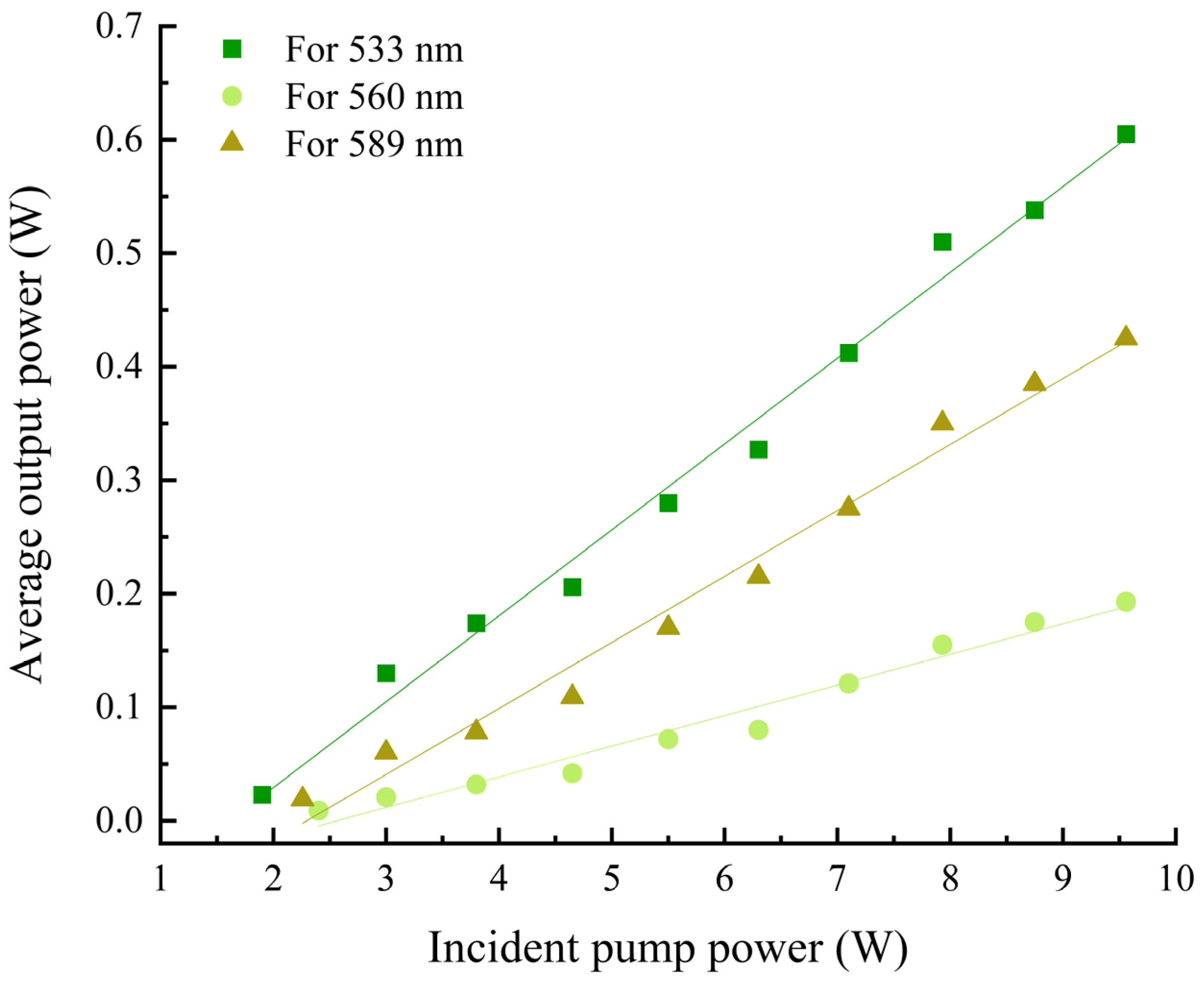
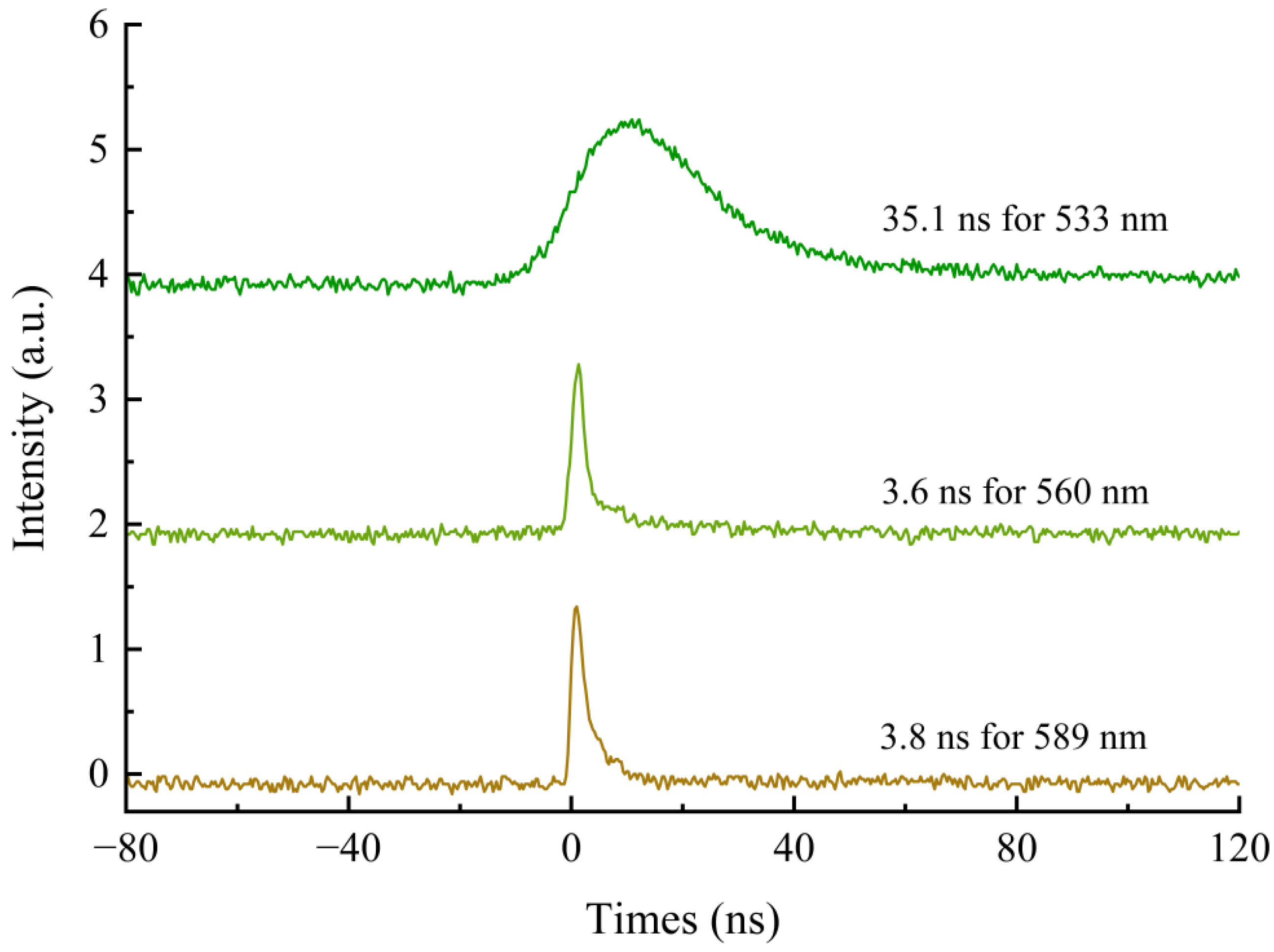
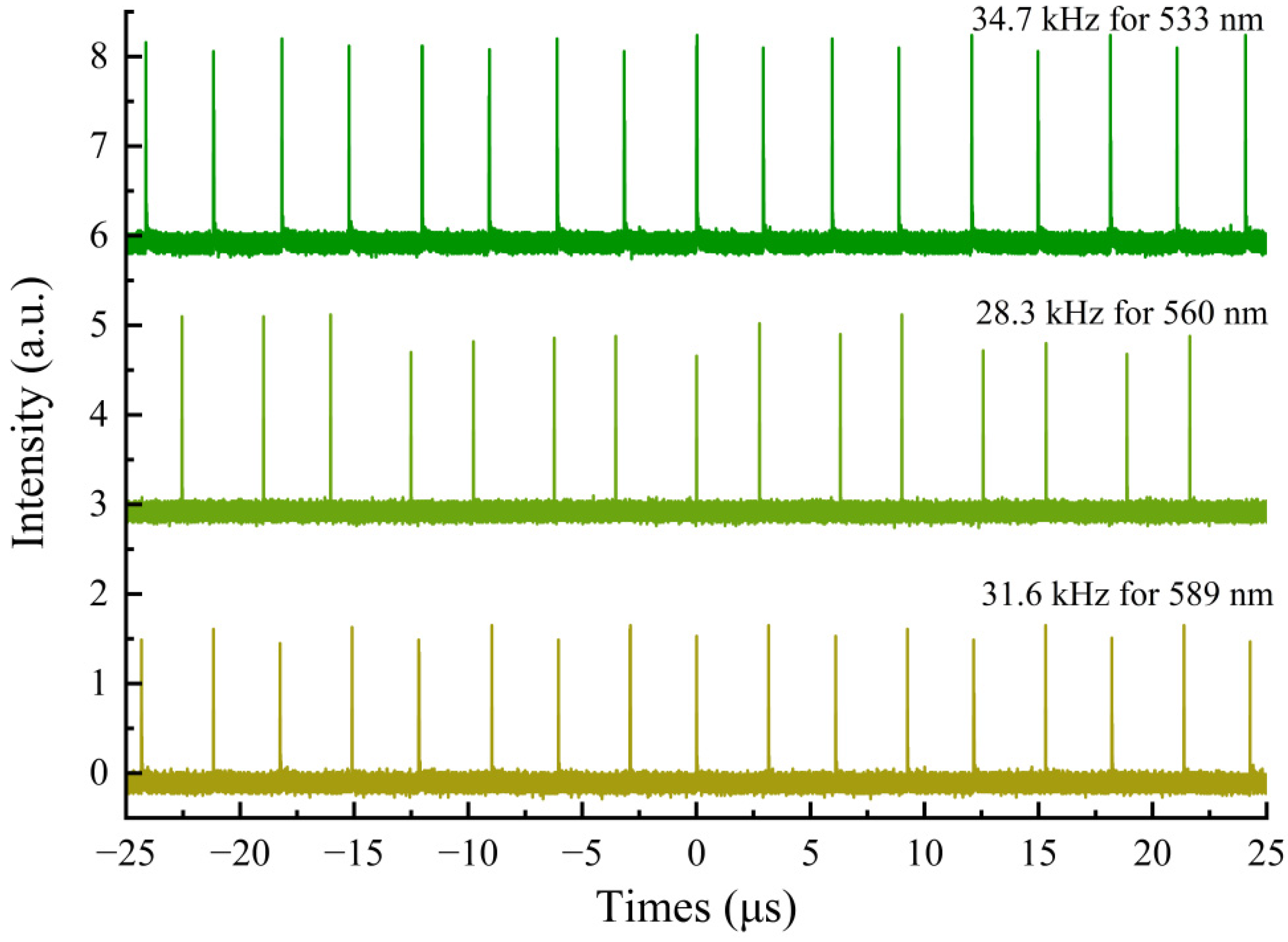
| Wavelength Conversion | 1066 nm SHG | 1066 nm and 1178 nm SFG | 1178 nm SHG |
|---|---|---|---|
| Output wavelength/nm | 533 | 560 | 589 |
| LBO NCPM temperature/°C | 146 | 87 | 40 |
| LBO CPM angle | |||
| BBO CPM angle |
Disclaimer/Publisher’s Note: The statements, opinions and data contained in all publications are solely those of the individual author(s) and contributor(s) and not of MDPI and/or the editor(s). MDPI and/or the editor(s) disclaim responsibility for any injury to people or property resulting from any ideas, methods, instructions or products referred to in the content. |
© 2025 by the authors. Licensee MDPI, Basel, Switzerland. This article is an open access article distributed under the terms and conditions of the Creative Commons Attribution (CC BY) license (https://creativecommons.org/licenses/by/4.0/).
Share and Cite
Li, S.; Zheng, S.; Zheng, B.; Wei, Y.; Zhang, Y.; Duan, Y.; Zhu, H. Visible Triple-Wavelength Switchable Emission Generated in Passively Q-Switched Nd:YVO4 Self-Raman Laser. Photonics 2025, 12, 669. https://doi.org/10.3390/photonics12070669
Li S, Zheng S, Zheng B, Wei Y, Zhang Y, Duan Y, Zhu H. Visible Triple-Wavelength Switchable Emission Generated in Passively Q-Switched Nd:YVO4 Self-Raman Laser. Photonics. 2025; 12(7):669. https://doi.org/10.3390/photonics12070669
Chicago/Turabian StyleLi, Songtao, Shengxi Zheng, Bowen Zheng, Yong Wei, Yongchang Zhang, Yanmin Duan, and Haiyong Zhu. 2025. "Visible Triple-Wavelength Switchable Emission Generated in Passively Q-Switched Nd:YVO4 Self-Raman Laser" Photonics 12, no. 7: 669. https://doi.org/10.3390/photonics12070669
APA StyleLi, S., Zheng, S., Zheng, B., Wei, Y., Zhang, Y., Duan, Y., & Zhu, H. (2025). Visible Triple-Wavelength Switchable Emission Generated in Passively Q-Switched Nd:YVO4 Self-Raman Laser. Photonics, 12(7), 669. https://doi.org/10.3390/photonics12070669





